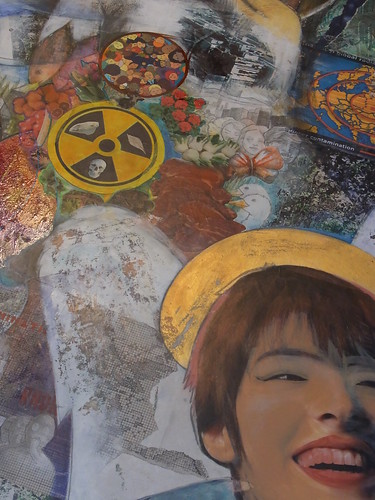The Fukushima Daiichi nuclear disaster was a series of equipment failures, nuclear meltdowns and releases of radioactive materials at the Fukushima I Nuclear Power Plant, following the Tōhoku earthquake and tsunami on 11 March 2011.[5][6]
It is the largest nuclear disaster since the Chernobyl disaster of 1986, says Wikipedia.
The plant comprises six separate boiling water reactors originally designed by General Electric (GE) and maintained by the Tokyo Electric Power Company (TEPCO).
Immediately after the earthquake reactors 1–3 shut down automatically and emergency generators came online to power electronics and coolant systems. However, the tsunami following the earthquake quickly flooded the low-lying rooms in which the emergency generators were housed. The flooded generators failed, cutting power to the critical pumps that must continuously circulate coolant water through a nuclear reactor for several days in order to keep it from melting down after being shut down. As the pumps stopped, the reactors overheated.
Power reactors work by splitting atoms, typically uranium, in a chain reaction. The reactor continues to generate heat after the chain reaction is stopped because of the radioactive decay of unstable isotopes, fission products, created by this process. This decay of unstable isotopes, and the decay heat that results, cannot be stopped. Nuclear fuel rods that have reached cold shutdown temperatures typically require another several years of water cooling in a spent fuel pool before decay heat production reduces to the point that they can be safely transferred to dry storage casks.
The earthquake was followed by a 43–49 ft height tsunami arriving approximately 50 minutes later which topped the plant's19 ft seawall,[73][74][75] flooding the basement of the Turbine Buildings and disabling the emergency diesel generators[76][77] located there[72].
Government agencies and TEPCO were thoroughly unprepared for the "cascading nuclear disaster".[91] The tsunami that "began the nuclear disaster could and should have been anticipated and that ambiguity about the roles of public and private institutions in such a crisis was a factor in the poor response at Fukushima".[91] In March 2012, Prime Minister Yoshihiko Noda said that the government shared the blame for the Fukushima disaster, saying that officials had been blinded by a false belief in the country's "technological infallibility", and were taken in by a "safety myth". Noda said "Everybody must share the pain of responsibility".[92]
According to Naoto Kan, Japan's former prime minister, the country was totally unprepared for the Fukushima disaster, and the crippled Fukushima plant should not have been built so close to the ocean on a tsunami-prone coast.[93] Kan has acknowledged flaws in authorities' handling of the crisis, including poor communication and coordination between nuclear regulators, utility officials and the government.
Japan’s "rigid bureaucratic structures, reluctance to send bad news upwards, need to save face, weak development of policy alternatives, eagerness to preserve nuclear power’s public acceptance, and politically fragile government, along with TEPCO’s very hierarchical management culture, also contributed to the way the accident unfolded. Moreover, the information Japanese people receive about nuclear energy and its alternatives has long been tightly controlled by both TEPCO and the government".[95]
There has been a significant re-evaluation of existing nuclear power programs in many countries. One poll found that what had been growing acceptance of nuclear power in the United States was eroded sharply following the 2011 Japanese nuclear accidents, with 43% approving and 50% disapproving of building new plants.[183] Events at Fukushima "cast doubt on the idea that even an advanced economy can master nuclear safety".[184] Increased anti-nuclear sentiment has been evident in India, Italy, Germany, Spain, Switzerland, Taiwan, and the United States.
Japan could have chosen to exploit the country's extensive renewable energy base. Japan has a total of "324 GW of achievable potential in the form of onshore and offshore wind turbines (222 GW), geothermal power plants (70 GW), additional hydroelectric capacity (26.5 GW), solar energy (4.8 GW) and agricultural residue (1.1 GW)."
Louisiana has two nuclear power plants on the Miss R that have been at work for decades. One is in St Charles parish below New Orleans; it is called the Waterford Steam Electric Station. One is near St Francisville, above Baton Rouge. It is the River Bend Nuclear Generating Station.
skip to main |
skip to sidebar
For students and parents who love education and exploration of the social sciences . . .
Search This Blog
Followers
Blog Archive
-
▼
2013
(99)
-
▼
May
(15)
- Semester geography exam review, May, 2013
- Semester exam schedule, Caddo Magnet HS, 5/20 - 5/...
- Japanese aesthetic: wabi and sabi
- Essay on making Japanese raku tea bowls
- Exam review of Coates Bluff nature Trail material
- Made in China by Foxconn: Kindles, Playstations, W...
- The ancient Silk Road and China
- A guide to the Mandarin Chinese movie, "Not One Less"
- Chinese manufacturing advancing rapidly: Geely's G...
- Mon, May 13: China reports via video
- Robert "Weiwei" Trudeau: adding a Chinese name in ...
- Your future: trends in petrochemicals and in clean...
- Tsunami / Earthquake and Nuclear Power Plant Meltd...
- Background on the Fukushima Nuclear Meltdown
- Semester exam study guide in world geography: 50 m...
-
▼
May
(15)

